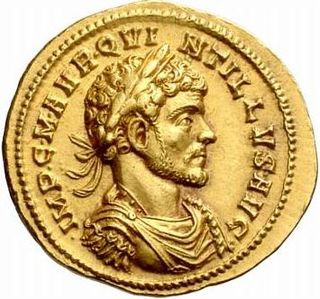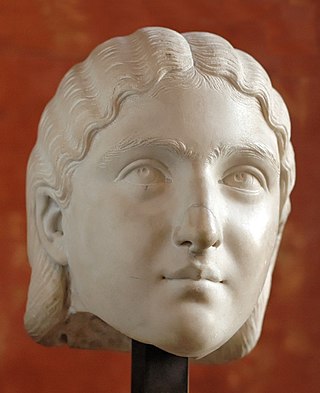
Lucius Septimius Severus was a Roman politician who served as emperor from 193 to 211. He was born in Leptis Magna in the Roman province of Africa. As a young man he advanced through the customary succession of offices under the reigns of Marcus Aurelius and Commodus. Severus seized power after the death of the emperor Pertinax in 193 during the Year of the Five Emperors.

The Severan dynasty, sometimes called the Septimian dynasty, was an Ancient Roman imperial dynasty that ruled the Roman Empire between 193 and 235, during the Roman imperial period. The dynasty was founded by the emperor Septimius Severus, who rose to power after the Year of the Five Emperors as the victor of the civil war of 193–197, and his wife, Julia Domna. After the short reigns and assassinations of their two sons, Caracalla and Geta, who succeeded their father in the government of the empire, Julia Domna's relatives themselves assumed power by raising Elagabalus and then Severus Alexander to the imperial office.

The Crisis of the Third Century, also known as the Military Anarchy or the Imperial Crisis (235–284), was a period in which the Roman Empire nearly collapsed. The crisis ended due to the military victories of Aurelian and with the accession of Diocletian and his implementation of reforms in 284.

Marcus Aurelius Antoninus, better known by his nickname Caracalla, was Roman emperor from 198 to 217 AD. He was a member of the Severan dynasty, the elder son of Emperor Septimius Severus and Empress Julia Domna. Proclaimed co-ruler by his father in 198, he reigned jointly with his brother Geta, co-emperor from 209, after their father's death in 211. His brother was murdered by the Praetorian Guard later that year under orders from Caracalla, who then reigned afterwards as sole ruler of the Roman Empire. Caracalla found administration to be mundane, leaving those responsibilities to his mother. Caracalla's reign featured domestic instability and external invasions by the Germanic peoples.

In ancient Roman religion, Aeternitas was the divine personification of eternity. She was particularly associated with Imperial cult as a virtue of the deified emperor (divus). The religious maintenance of abstract deities such as Aeternitas was characteristic of official Roman cult from the time of the Julio-Claudians to the Severans.

In ancient Roman religion, Roma was a female deity who personified the city of Rome and more broadly, the Roman state. She was created and promoted to represent and propagate certain of Rome's ideas about itself, and to justify its rule. She was portrayed on coins, sculptures, architectural designs, and at official games and festivals. Images of Roma had elements in common with other goddesses, such as Rome's Minerva, her Greek equivalent Athena and various manifestations of Greek Tyche, who protected Greek city-states; among these, Roma stands dominant, over piled weapons that represent her conquests, and promising protection to the obedient. Her "Amazonian" iconography shows her "manly virtue" (virtus) as fierce mother of a warrior race, augmenting rather than replacing local goddesses. On some coinage of the Roman Imperial era, she is shown as a serene advisor, partner and protector of ruling emperors. In Rome, the Emperor Hadrian built and dedicated a gigantic temple to her as Roma Aeterna, and to Venus Felix,, emphasising the sacred, universal and eternal nature of the empire.

Hostilian was briefly Roman emperor in 251. Hostilian was born to Decius and Herennia Etruscilla at an unknown date and elevated to caesar in 250 by Decius. After Decius and Herennius Etruscus, Hostilian's brother, were killed at the Battle of Abritus, an ambush by the Goths, Trebonianus Gallus was proclaimed emperor by the legions. Almost immediately, he elevated Hostilian to co-emperor and his own son, Volusianus, to caesar. Hostilian died soon after, either due to plague or being murdered by Trebonianus Gallus.

Marcus Aurelius Claudius Quintillus was a Roman emperor. He was a brother of Emperor Claudius Gothicus, whom he succeeded after Claudius' death in 270. Quintillus' claim to be emperor was challenged by Aurelian, who was proclaimed emperor by the legions he commanded. Quintillus' reign lasted no more than six months. Different sources report his cause of death as murder by his own soldiers, in battle with Aurelian, or by suicide.

Publius Septimius Geta was Roman emperor with his father Septimius Severus and older brother Caracalla from 209, when he was named Augustus like his brother, who had held the title from 198. Severus died in 211, and although he intended for his sons to rule together, they proved incapable of sharing power, culminating with the murder of Geta in December of that year.

Roman currency for most of Roman history consisted of gold, silver, bronze, orichalcum and copper coinage. From its introduction during the Republic, in the third century BC, through Imperial times, Roman currency saw many changes in form, denomination, and composition. A persistent feature was the inflationary debasement and replacement of coins over the centuries. Notable examples of this followed the reforms of Diocletian. This trend continued with Byzantine currency.

Julia Domna was Roman empress from 193 to 211 as the wife of Emperor Septimius Severus. She was the first empress of the Severan dynasty. Domna was born in Emesa in Roman Syria to an Arab family of priests of the deity Elagabalus. In 187, she married Severus, who at the time was governor of the Roman province of Gallia Lugdunensis. They had two sons, Caracalla and Geta. A civil war over the Roman throne broke out in 193, and shortly afterwards Severus declared himself emperor. The war ended in 197 with the defeat of the last of Severus's opponents.

Diadumenian was the son of the Roman emperor Macrinus and served as his co-ruler for a brief time in 218. His mother, Macrinus' wife, is called Nonia Celsa in the unreliable Historia Augusta, though this name may have been fictional. Diadumenian became caesar in May 217, shortly after his father's accession to the imperial throne. Elagabalus, a relative of the recently deceased Caracalla, revolted in May of the following year, and Diadumenian was elevated to co-emperor. After Macrinus was defeated in the Battle of Antioch on 8 June 218, Diadumenian was sent to the court of Artabanus IV of Parthia to ensure his safety; however, he was captured and executed along the way. After his death and that of his father, the Senate declared both of them enemies of Rome and had their names struck from records and their images destroyed — a process known in modern scholarship as damnatio memoriae.
Roman usurpers were individuals or groups of individuals who obtained or tried to obtain power by force and without legitimate legal authority. Usurpation was endemic during the Roman imperial era, especially from the crisis of the third century onwards, when political instability became the rule.

Sponsianus, also known in English as Sponsian, may have been a Roman usurper during the third century. His existence is implied by a series of coins bearing his name, ostensibly part of a hoard excavated in the eighteenth century. No corresponding figure named Sponsianus is mentioned in any ancient sources, and the coins are widely believed to be the work of modern forgers. However, a study of wear marks on the coins published in November 2022 concluded that the coins were authentic, supporting Sponsian's existence as a historical figure. The study's methodology and conclusions have been criticized by a number of scholars.

Gaius Vibius Volusianus was a Roman emperor from 251 to 253, ruling with his father Trebonianus Gallus.

In ancient Roman religion, Annona is the divine personification of the grain supply to the city of Rome. She is closely connected to the goddess Ceres, with whom she is often depicted in art.

The Roman imperial cult identified emperors and some members of their families with the divinely sanctioned authority (auctoritas) of the Roman State. Its framework was based on Roman and Greek precedents, and was formulated during the early Principate of Augustus. It was rapidly established throughout the Empire and its provinces, with marked local variations in its reception and expression.

Gnaea Seia Herennia Sallustia Barbia Orbiana, usually known as Sallustia Orbiana, was a third century Roman empress, with the title of Augusta as the wife of Severus Alexander from AD 225 to 227. The emperor married her in late 225, following the death of his grandmother. Severus was around sixteen years of age at this time. She was known for her beauty, which was captured in multiple works of art. Possibly a victim of the jealousy of Julia Mamaea, the emperor's mother, Orbiana was divorced and exiled to Libya in 227.

Gaius Julius Sohaemus was a Roman client king of Armenia.

Fortuna Redux was a form of the goddess Fortuna in the Roman Empire who oversaw a return, as from a long or perilous journey. Her attributes were Fortuna's typical cornucopia, with her specific function represented by a rudder or steering oar sometimes in conjunction with a globe.






















